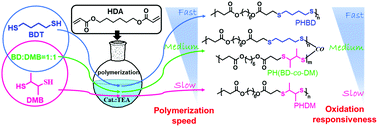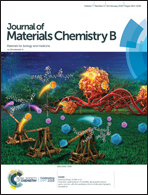The polymerization kinetics, oxidation-responsiveness, and in vitro anticancer efficacy of poly(ester-thioether)s†
Abstract
Biodegradable and stimuli-responsive polymers have been widely explored due to their great potential in various biomedical applications. Here, biodegradable and oxidation-responsive poly(ester-thioether)s with different backbones were prepared by polymerization of dithiols and diacrylates. Two isomeric dithiol monomers, 2,3-dimercaptobutane (DMB) and 1,4-butanedithiol (BDT), were employed to synthesize poly(ester-thioether)s in the presence of 1,6-hexanediol diacrylate (HDA). The polymerization and oxidation kinetics of poly(ester-thioether)s were found to be controllable by tuning the polymer backbones, which were prepared using different monomers. The polymerization kinetics demonstrated that BDT showed a faster polymerization rate than DMB due to less steric hindrance. Poly(ester-thioether)s PHBD and PHDM, which were prepared from BDT and DMB with HDA, respectively, showed the fastest and slowest oxidation-responsiveness both in THF solution and in the form of polymer films. Finally, the potential application of poly(ester-thioether)s as drug vehicles for anticancer therapy was confirmed by using doxorubicin (DOX) as a model drug. The DOX-loaded micelle DOX/mPEG-PHBD showed much faster H2O2-responsive drug release and better anticancer efficacy in both MCF-7 and 4T1 cells due to the higher sensitivity of PHBD to H2O2.



 Please wait while we load your content...
Please wait while we load your content...